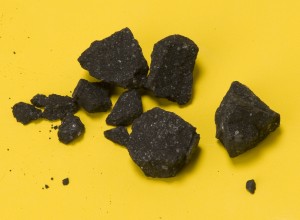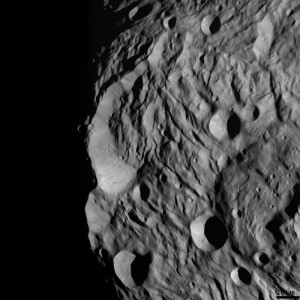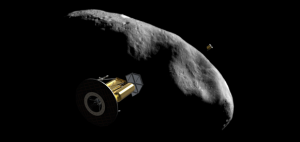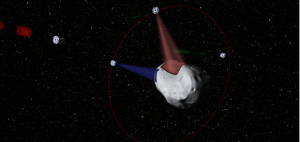Last Tuesday, the future finally sounded like the future. A coalition of willing billionaires, spaceflight professionals, and scientific advisors under the banner of Planetary Resources announced their deadly serious intention to go out there and mine themselves some asteroids (video). And the scientific community responded with a heartfelt finally. Assuming this plan isn’t the prelude to some kind of Bond-villian-esque scheme to hold the world hostage for trillions of dollars or they’ll drop an asteroid on our heads (note to self: screenplay??), what’s going to happen? What does it mean for astronomers and planetary scientists? What contributions will the scientific community make, and what data do we stand to gain?

Fragments from the recent meteorite fall over California and Nevada, which has been identified as a rare carbonaceous chondrite. Though they make up a small percentage of falls, carbonaceous chondrite asteroids are abundant in space. (Image credit: Image Credit P. Jenniskens (SETI Institute) and Eric James (NASA Ames))
Asteroids are not just little floating gold mines, they’re precious scientific relics. They are the only nearby remnants of the presolar nebula, and preserve a vast trove of data about the cloud of gas and dust that formed our Sun and Solar System, the processes that built up the planets, and even fragments of what came before. Asteroids can provide vital insights into theories of planet formation by telling us about disk composition and temperature. They preserve the history of the processes that built them up, telling us about how dust and rock clump together to form larger bodies, a subject of great interest to those who study extrasolar planets. They’re also the best source for the composition of the presolar nebula, and by extension provide one of the benchmarks for the solar abundance set, or the relative abundances of the chemical elements, key to our understanding of nucleosynthesis and related topics. Right now, however, our only access to asteroids is via meteorites (ah, astronomy; where waiting for research material to fall out of the sky is a viable strategy). Meteorites are often found after sitting on the surface for a long time, enduring Earth’s many chemical processes. This destroys any volatiles that may have been retained, and introduces contamination. And they’re quite rare. In particular the CI carbonaceous chondrite group, upon which the solar abundance set is benchmarked, is very rare; the majority of our data comes from 12 pounds of rock in a jar in France.
So astronomers and planetary scientists would love to get their hands on tons of pristine space rock. Why haven’t we done it yet? Mining asteroids – or at least returning samples from them – has long been a staple not just of science fiction, but of decadal surveys and mission concepts. NASA, JPL, and even some private firms have studied mission concepts for sample returns and rendezvous with asteroids for a long time. But only a few targeted missions have been launched, such as the Dawn spacecraft currently studying the asteroid Vesta and the Japanese Hayabusa spacecraft, which successfully returned 1500 grains of material from the Near-Earth asteroid 25143 Itokawa. Other spacecraft such as Deep Space 1 and Galileo have swung by asteroids on their way to other destinations, but done little more than photograph the objects in passing. And NASA’s planetary science budget has suffered greatly in recent years as the agency struggles to keep JWST alive in the face of Congressional budget cuts.

The giant asteroid Vesta, as imaged by the Dawn spacecraft. (Image credit: Image Credit: NASA/JPL-Caltech/UCLA/MPS/DLR/IDA).
Recently, however, interest has been growing in Near-Earth Asteroids (NEAs) not just as potential scientific targets or potential hazards, but as stepping stones for revitalizing the space exploration program. After the Moon, Near-Earth Asteroids are the closest bodies to Earth that could be the target of human missions. The Augustine Report, which set out to chart the future of NASA’s human spaceflight plans, recommended asteroid exploration as the next phase of manned missions, and the White House endorsed the idea. Several mission concepts have been offered up, some manned and some robotic. But so far no firm plans have been made. Until now. Planetary Resources, whose headliners include Larry Page and Eric Schmidt from Google, director James Cameron, Peter Diamandis from the X-PRIZE foundation, Chris Lewicki of Spirit and Opportunity fame, and Dr. Sara Seager from MIT (seriously guys, Bond movie plot), have decided to take matters into their own hands.
How are these guys different from any other pie-in-the-sky startup dreaming of a huge payoff? All of us have heard grandiose claims about the future of space exploration before. How do we know we’re not going to get our hearts broken again? Well, the ideas they’ve put forward, the team they’ve assembled, and the resources this group can bring to bear are remarkable enough for everyone to give them a second look. Just the fact that they have a plan rather than simply making a grand proclamation is a good sign.
Planetary Resources’ mining strategy as currently described comprises four stages: survey, using cheap robotic telescopes to catalogue NEAs; reconnaissance, using small satellites to fly past asteroids passing close to Earth; assessment, sending robotic spacecraft to study potential targets; and mining proper, when the resources are finally extracted. Let’s break it down step by step. If you’d like to watch some videos on the subject, by the way, the company has posted several on their Youtube channel.

The Leo telescope, aka Arkyd 100 series. A small, cheap telescope meant to survey for NEAs. (Image credit: Planetary Resources).
Survey: The first stage of the Planetary Resources plan is simply to launch a fleet of robotic telescopes into low Earth orbit (LEO) expressly for the cataloguing of asteroids. Although NASA’s Spaceguard program has catalogued about 93 percent of the large (> 1km) NEAs, there are still plenty of mid-size and smaller objects to be found. Because NEAs are small, dark objects, it’s hard to find them. New objects are being discovered all the time, and a fleet of telescopes that do nothing but look for them can only be good for astronomers. The Planetary Resources plan describes a small satellite called “Leo” mounting a telescope with arcsecond resolution. Their description also implies that time on the Leo telescopes may be publicly available for purchase, which could be interesting. No word on what band these telescopes operate in, but if they’re smart, they’ll put at least a few in the mid- to far-infrared – as this article describes, far-infrared telescopes are better at finding asteroids because they can see their thermal emission rather than just searching for reflected sunlight.
Feasibility: Let me dust off my aero/astro degree here for a second. According to Phil Plait, the Leo telescopes will have a mirror diameter of 9″, quite sufficient to give arcsecond resolution, and an overall satellite size of 16″. This miniscule form factor is absolutely vital; the single biggest line-item in any small satellite project is far and away the launch, so Planetary Resources is going to take advantage of so-called “secondary payloads,” smaller cargo carried to fill out a rocket that’s hauling a much larger satellite. In order to take advantage of these piggyback rides into space, however, the Leos must be small enough to pack into a payload shroud without disturbing the prime cargo. I’d guesstimate their overall weight in the realm of 50 – 75 kg, within the standard limits for ESPA ring launches (one image on the website even shows what looks like an ESPA ring connector plate attached). Eyeballing the graphics on the website, it looks like the Leo satellites have a system of cold-gas thrusters for pointing, probably coupled with a set of small reaction wheels. They have a single small solar panel that likely doubles as a sunshield for cooling the camera and the electronics, and possibly a couple of star trackers for orientation and navigation. It’s a fairly standard small satellite design and eminently feasible. Order-of-magnitude I’d guess each bird will cost in the neighborhood of $1-2 mil in parts and labor.
Planetary Resources says they’re going to launch several of these, which could be a costly endeavor, and that they’re making them in-house – that, in fact, they’ve already started. Making them in bulk will make things easier – if one fails, just iterate on the next one – but regardless of how off-the-shelf the technology may seem, putting anything in space is never an easy or routine operation. Still, this is something that has been done before.

The Interceptor spacecraft, planned to perform flybys of NEAs crossing through the Earth-Moon system. (Image credit: Planetary Resources).
Reconnaissance: The second phase described by Planetary Resources involves fitting out a couple of the Leo telescopes with rocket motors and slinging them up past geosync to flyby asteroids passing through the Earth-Moon system. A surprising number of NEAs pass between the Earth and the Moon, and a disturbing portion of them are only spotted during near-misses with Earth. Presumably the Leo network from the first phase will come into play here, spotting a flyby candidate in time for a rendezvous to be arranged. These “Interceptor” missions will try to hitch a ride with satellites heading not to the relatively nearby confines of LEO, but the distant reaches of geosynchronous orbit (GEO), about 40,000 km out; from there it only takes a relatively small additional boost to push themselves far away from Earth. These satellites would study passing asteroids much more closely, and with a wider suite of scientific instruments. There’s even a mention of a possible sample return from one of these flybys, a prospect that should make all astronomers giddy.
Feasibility: Hitching a ride to geosynchronous orbit is a trickier proposition. Boosting an object up to geosynchronous orbit takes a lot more energy than low Earth orbit, so a rocket that can put N tons into LEO can only put a small fraction of that into GEO. That means payload space is much tighter heading up to GEO, leaving far less room for hitchhikers. The extra poundage of the added scientific instruments and the rocket maneuvering system will also probably beef the Interceptor spacecraft up to 150 – 200 kg. But that’s well within the realm of possibility, and there’s no reason these spacecraft couldn’t get a great look at an asteroid as it cruises by. Sample return may be harder to manage in such a small package. Hayabusa managed to return a sample, but that spacecraft was purpose-built, and even then only got the sample back by the skin of its teeth.

A fleet of prospecting spacecraft assessing a potential mining target. (Image credit: Planetary Resources).
Assessment: Once we’ve catalogued the NEAs, it’s time to pick out our favorites. The Interceptor satellites already have, in theory, everything they need to operate away from Earth. This phase involves outfitting the satellites with “deep space laser communication technology” and sending them out away from Earth entirely to meet up with the chosen asteroids. There the spacecraft, or more likely the group of spacecraft, will park themselves in a matching orbit and survey the asteroid with all the instruments at their disposal. They’ll be able to collect all the data necessary for a more permanent rendezvous, such as maps of the surface and measurements of rotation rates and density. No word on whether this phase of the mission also has the potential for sample return, but it would be an obvious place to do it. Scientifically this phase is rich. Detailed, up-close data from several asteroids would be great news for a lot of astronomers. Hopefully at this point NASA will also be building their own missions to survey and possibly send manned missions to NEAs, and the synchronization of the two could provide a wealth of fresh data.
Feasibility: Launching satellites into Earth-trailing or Earth-leading orbits has been done many times. Really the unusual part about this phase is the addition of laser communication. Laser communication in space is a new technology that has great promise, but not a lot of proven reliability. Currently, deep space missions use radio communications, so the signal spreads out according to the inverse square law as it travels. This means that spacecraft traveling farther from Earth see nonlinear increases in the amount of power, and therefore size and mass, required to sustain communication. Deep-space missions have data transfer rates that would make the 1980s laugh. Laser communication, by contrast, promises a much more focused signal at lower power. It’s a great innovation and one that has a lot of potential for dropping the cost of deep-space missions. But it’s not entirely a proven technology. The MESSENGER spacecraft was able to signal Earth with an onboard laser during a flyby, and NASA has lofted a Technology Demonstrator Mission to study it, but that’s about it. Laser communication is key to preserving the second phase design without heavy modification, and keeping the size and weight of the satellite down to the level where it can reasonably piggyback on other launches.
Mining: After all this exhaustive surveying and assessment, it’s time to reap the rewards. It’s not clear how Planetary Resources plans to actually mine the asteroids. However, they aren’t going to just haul a rock into Earth orbit and start breaking it down for scrap. One of the aims of their mining program is to harvest not just precious metals but volatiles such as oxygen or water that are key to future manned spaceflight missions. Every pound of water or air on a manned mission must be hauled up from the surface of the Earth at a cost of roughly $50,000 per kilogram. Since volatiles captured from an asteroid are already in space, they can be had for a fraction of the cost. I can imagine robotic probes carving ice from an asteroid, to be slung back to the Earth-Moon system and picked up by a manned mission waiting in LEO to fuel up before heading off to parts unknown. A mission to a destination such as Mars might even plan to meet up with asteroid-launched containers of volatiles along the way. Solving the volatile problem would make planning human missions orders of magnitude easier – and cheaper. In the end this might be the most valuable contribution of the program. I’m not going to assess the feasibility of this part, because it’s far enough into the future that who knows what kind of tech we’ll have around.
So there you have it. At first glance, this plan sounds like science fiction. At second glance, it totally is. But that’s okay, because this is the future and if it doesn’t sound like science fiction then you haven’t been paying attention. It is a remarkably well-thought out plan that seems to have some serious engineering backing it up. More importantly, it doesn’t rely on too many unspecified, as-yet-undiscovered technological advances like many other doomed startups. The tech described has largely been invented, and requires only resources and ingenuity to combine into a working program. The slew of backers makes me think this isn’t a group that will give up easily, and they certainly have the resources to pour into it to keep things alive till the big payoff at the end. And what does this mean for us as scientists? If the program gets off the ground, we stand to harvest an incredible trove of data, particularly with planetary science budgets being slashed.

An unusual asteroid trailing a debris tail, likely the result of a collision in the main asteroid belt between Mars and Jupiter. (Image credit: Credit: NASA, ESA, D. Jewitt (UCLA)).
But it’s not clear how science will be incorporated into the program, and that worries me. There are some concerns about the fact that Planetary Resources is a private company. First of all, we don’t know how public the data from their surveys will be. And because their motives are, ultimately, profit, their list of target asteroids may not sync up with a scientist’s priorities. An astronomer interested in the composition of the presolar nebula, for example, will want to investigate the stony carbonaceous chondrite asteroids, which would be of little interest to a miner interested in platinum-group metals. An astronomer might be reluctant to dismantle an asteroid for fear of disturbing potential data, while a miner’s entire plan is to take it apart. Scientific study and resource exploitation can coexist, often quite fruitfully – in this case it will require astronomers to tell the miners where to mine, and miners to get the astronomers their data – but that does not mean the relationship will not be tense at times. This is not a government mission, where scientists can argue for control on the grounds of public benefit; it’s privately-funded and privately-executed, meaning Planetary Resources can act as they will.
Plus, there are legal intricacies to be tackled. The current treaties governing space and space resources classify asteroids as scientific resources that cannot be used for commercial exploitation. However, a lot of the treaty language is deliberately vague. This program isn’t going to plant the first shovel in an asteroid’s surface for several years at the least, so there’s time to work out the law in advance. But if there is a conflict between the priorities of the scientific community and the commercial concerns, it could get messy.
Despite these concerns, I’m all for it. I think this can work, and I really, really hope it can work. There is a deeper motive here. In other sciences, the counterpart to a theorist is an “experimentalist.” In astronomy, it’s an “observer.” By and large astronomy is the science of staring at things you know you will never touch. None of us will ever see the objects we study firsthand. Excepting those few lucky scientists working on planetary missions, we will never be able to interact with our subjects. Sometimes it is easy to feel as though the sky itself is just a big globe encircling the Earth, and astronomers are engaged in a thorough study of the wallpaper. When a meteorite falls, a piece of the stars has come to Earth. For one brief moment, we can touch what we have spent our lives watching.
It’s time to stop waiting around for our field to come to us. It’s time for us to go out and find it.






This is a beyond-ridiculously great and well-written article to not have any comments at this point. Fine. I’ll stop lurking and do it: bravo! (brava)
Loved it. Thanks, and thanks for doing a much better job assessing and breaking down the news of Planetary Resources than anybody else I’ve read. And there’s been a ton of them, before and after last Tuesday’s “official” word. I’ve pretty much enjoyed all of them as I eagerly dream of what may be but yours is tops. Not only well-informed and informative, and hitting everything interesting, and no lame grammar or spelling errors, and a well structured essay, but also…. Ahhh, humor, and perfectly executed too. THANK YOU, for the occasional quirky funny or casual use of words that you sprinkled around like delicious cake crumbs to keep the mouse going.
Anyway, no intelligent value-adding discussion here, just a tweet and now that “thanks” because your effort is much appreciated and not unnoticed!
Michael
Hi Elizabeth
Nice and informative article.
You do not seem to be aware of the NASA funded mission already underway (Phase B)
to reach a carbonaceous asteroid and provide a sample return, being led by Dante Lauretta at the Lunar and Planetary Lab at U of Arizona.
http://osiris-rex.lpl.arizona.edu/downloads/OSIRIS_REx_infosheet.pdf
Gilda Ballester,
LPL, UofA
I was not! In determining the active and pipeline missions I mostly went by the NASA and JPL mission pages, plus the decadal survey, and I must have missed this one. It looks fascinating, and I certainly hope it gets off the ground sooner rather than later. A sample from a carbonaceous asteroid would be wonderful!
— Elizabeth L.